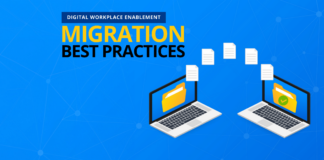Haven’t migrated to Microsoft 365 yet? Learn how with our webinar “Move to Microsoft 365 Fast and Accelerate Remote Work!“
As everyone is fully aware by now, the push to remote work in 2020 has created an unprecedented shift to leveraging new platforms to accommodate the needs of the workforce. In my own experience, I’ve seen many organizations either accelerate their move to the cloud and cloud-based collaboration platforms or implement a cloud-first strategy within organizations that previously said they’d never fully adopt.
This shift in priority has seen platforms such as Microsoft Teams see their user counts explode beyond one billion users worldwide (and growing)! This is great news for the companies that provide these platforms, but a quick glance at these extraordinary numbers begs a very simple question: how did so many organizations onboard so many users onto new technology so quickly?

Now, granted, a number of organizations (roughly 45%) had already planned to move a majority of their assets into the cloud by the end of 2020 according to a report conducted by O’Reilly Media. These organizations have:
- Done the research to determine the right platform to meet the needs of all of their business units,
- Put in place governance and planning committees to identify the optimal way to roll out this new technology with minimal business disruption, and
- Implemented an ongoing support structure to sustain continued success and growth for the platform of choice.
That being said, that still leaves 55% of organizations that had no such plans, and many others that were forced to accelerate those timelines. So, how are we still seeing such a drastic increase in adoption so quickly?
The prevailing trend that many of these organizations have taken is the greenfield approach. This approach essentially allows organizations to leave their legacy assets as-is and drive all net new work and collaboration to more modern platforms. So, is a greenfield approach right for you?
Unsure if your org should leverage the greenfield approach for M365 migration? Check out this post: Click To TweetThe Goal of Greenfield: Drive Adoption and Avoid the Hassle
On the surface, a greenfield approach seems like the best of both worlds. As an organization, you would no longer be required to go through the arduous task of a full organizational change management initiative that includes tasks such as:
- Identifying what aspects of the legacy platform map to the new one and which do not
- Aligning established routines and user experiences into the new platform
- Continuous communication with the end user community as they both learn a new platform while simultaneously retraining them on how to interact with their legacy data within that new platform
- Migrating legacy content into the new platform, which can be costly and time-consuming.
Instead, greenfield lets users work as they’ve always worked with the data and content in your legacy systems and simply point them to the new platform for net-new. Eventually, users will only leverage the new platform for their needs and organizations can sunset their legacy applications. This approach has seen a drastic spike in adoption for many organizations, so what’s the catch?

The Reality of Greenfield: Ineffectual Collaboration
There are a number of reasons why organizations have historically chosen to migrate from legacy platforms to new ones, a primary one being the reduction of technical debt. In 2020, though, we’ve seen a new reason for migration arise: increased productivity.
A recent American study of 1,100 companies carried out by the Institute for Corporate Productivity and Professor Rob Cross of Babson College in Massachusetts found those that promoted collaborative work environments were five times more likely to be high performing. Without going into detail regarding the merits of collaboration, it’s rather clear that when done correctly, it can greatly improve the overall performance of an organization.
But where does collaboration fail or, more specifically, where does an enterprise collaboration strategy fail? The answer to that question can vary from organization to organization, but some common themes are:
- End-user confusion: what platform should I use when?
- Lack of visibility: collaboration silos are created, driven by the location of the data being worked on
- Disjointed or haphazard ways of working: each user, team, or business unit is left to determine their own way of collaborating and navigating multiple platforms

A greenfield approach can often succumb to all the above pitfalls. For example, let’s say an organization that historically leveraged on-premises SharePoint as their collaboration platform deploys Microsoft 365 and Teams with some end-user training.
- Where should active collaboration content reside? When is it appropriate to collaborate on-premises v cloud? How often will a user need to make this decision?
- What is driving the use of the new platform? Users and business units reluctant to change will most likely remain on-premises. What happens when there needs to be collaboration across business units?
- A business unit uses Teams for chat and for informal collaboration, but their legacy SharePoint site for formal collaboration. Some users share links, others use attachments in emails, and others simply upload content to both locations.
The result of this is typically an initial spike in adoption (it’s the new way to work!) with a gradual decline as users find it harder and harder to find what they need and be confident they are doing the right thing.

The Solution: Accelerated Migration
Organizational change management is always more difficult in remediation than it is on launch. The most successful rapid deployments of Microsoft 365 and Teams we’ve seen this year follow some very basic guidelines:
- OCM-light: Deadlines no longer offer many organizations the ability to perform a full OCM analysis and strategy. Instead, identify the methods and requirements that satisfy the majority of business needs, and implement an ongoing adoption framework to incorporate more specific requirements later.
- Implement controls: Both from a process and technology standpoint, align your organization’s collaboration goals with the proper controls to help your users do the right thing
- Migrate relevant content: The biggest inhibitor of successful adoption is having business-critical data located in other systems. Understand what content that is most critical and active within your organization and focus your initial efforts there. Other content can always be moved at a later date.






